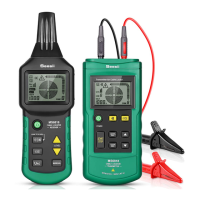Operating instructions for Cable Detector, article 37270766
Page 7 of 34
1. Measurements in dangerous proximity to electrical systems may be made only under the direction of
a responsible electrician.
2. If the device is used to test a live wire, make sure that the test lead is removed from the component
under test before connecting or disconnecting the test lead of the transmitter, and tell people in the
vicinity to protect themselves well.
3. Never attempt to disassemble the batteries! The batteries contain very strongly alkaline chemicals.
They can cause chemical burns. If the contents of the battery come into contact with skin or clothing,
rinse immediately with water and remove contaminated clothing. If the contents of the battery come
into contact with the eyes, rinse immediately with water and get medical help.
4. Connecting the transmitter to the grid can generate a current in the milliampere range in the circuit in
live condition, so the transmitter can be grounded only on a neutral conductor. If the transmitter
connection is from the phase to the protective conductor, the functional safety of the protective
conductor must first be tested per DIN VDE 0100, because all components connected to ground when
the transmitter is connected from phase to ground can become live in the event of a fault (if the
grounding resistance is not in accordance with requirements).
5. If operator safety is no longer assured, the test device must be taken out of operation and secured
against further use. Safety is no longer assured if the device:
Has obvious damage;
Does not perform the desired measurements;
Was stored too long under unfavourable conditions;
Was mechanically stressed during transportation.
6. The test device may be used only for the intended purpose under the intended conditions. Operating
safety is no longer assured if the device is modified or altered.
1. The operating temperature of the cable detector is between 0 - 40 °C (32 -104 °F).
2. To avoid damage, the device should be protected from excessive mechanical vibration during use, and
especially against falling.
3. Only persons with the proper knowledge may calibrate and repair this instrument.
4. Before use, check the instrument and the test leads used for external damage. Make sure that the test
device and test leads are intact. The instrument may be used only after all of its functions have been
thoroughly prepared for the use.
5. When the device is in use, the rated voltage of the conductor under test may not be greater than the
rated voltages given in the technical specifications of this cable detector.
6. Protect the device from direct sunlight, to ensure proper functioning and long operating life.
7. If the test device is exposed to an extremely strong electromagnetic field, its functioning may be
impaired.
8. Use only the batteries named in the Technical Specifications section.
9. Protect the batteries from moisture. If a blinking battery symbol appears on the display, the batteries
need to be replaced.
1. If the cable detector has been stored or transported under extreme climate conditions, leave it in a
permissible (rated) environment for a while before using.
2. If the transmitter is connected to a live grid and the ground connection of the transmitter is connected
to a ground protective phase, the fault current (if present) in the power supply line can combine with
the current in the transmitter circuit to trip the fault-current circuit breaker i.e. trigger FI/RCD.
3. Please keep the original packaging for later shipping (for example, for calibration).

